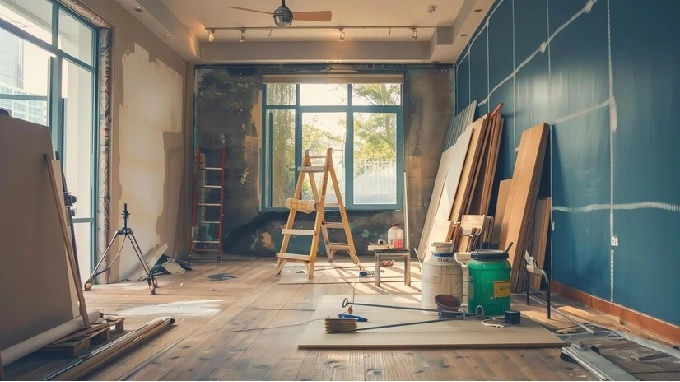How to Approach a Whole-House Renovation Step by Step

Are you dreaming of transforming your entire home with a whole-house renovation? It’s an exciting yet daunting prospect, and careful planning is essential to ensure a successful outcome. A whole-house renovation involves much more than just remodeling a kitchen or bathroom – it’s a comprehensive overhaul that can breathe new life into your living space and significantly increase your property’s value.
In this article, we’ll guide you through the entire home renovation process, from setting goals and establishing a budget to hiring professionals and managing the timeline. Our aim is to provide you with the knowledge and confidence to embark on your home renovation project, ensuring a smooth and rewarding experience.
Key Takeaways
- A whole-house renovation is a significant project that involves remodeling multiple rooms and may include structural changes.
- Proper planning is crucial to ensure your renovation project stays on track and within budget.
- Establishing clear goals, creating a detailed plan, and hiring the right professionals are key steps in the renovation process.
- Renovations can increase your home’s value and improve your living space, making it more functional and enjoyable.
- Regular communication with contractors and flexibility in your renovation timeline are important for managing delays and challenges.
Preparing for Your Whole-House Renovation
Setting Goals and Objectives
Before diving into your renovation, it’s essential to identify your goals and objectives. Are you aiming to modernize an older home, expand your living space, or improve energy efficiency? Understanding your primary purpose will guide your decision-making throughout the project.
It’s also important to distinguish between your needs and wants. Needs are essential elements that must be addressed, such as updating outdated plumbing or improving energy efficiency. Wants, on the other hand, are desirable but non-essential features, like a luxury kitchen island or a home theater. Prioritizing your needs vs. wants will help you allocate your budget effectively and ensure that critical areas are not overlooked.
Establishing a Budget
Renovating an entire house is a significant financial undertaking, and understanding the costs involved is crucial. On average, a whole-house renovation can cost anywhere from $60 to $150 per square foot, but this can vary depending on the scope of work and the materials used.
Here’s a breakdown of potential costs to consider:
- Materials: This includes everything from flooring and appliances to fixtures and finishes. The cost of materials can vary widely depending on your choices, from budget-friendly options to high-end, luxury items.
- Labor: Contractor fees will make up a significant portion of your budget. The cost of labor depends on factors such as the complexity of the work, the experience level of the contractors, and the local market rates.
- Permits: Depending on the type and scope of your renovation, you may need various permits, such as building, electrical, or plumbing permits. These permits ensure that your project complies with local building codes and safety standards.
It’s important to include a contingency fund in your renovation budget, typically around 10-20% of the total estimated cost. This fund will cover unexpected expenses that may arise during the renovation, such as unforeseen structural issues or supply chain delays.
Researching and Hiring Professionals
Unless you’re a seasoned DIY enthusiast, hiring professionals is essential for a whole-house renovation. The type of experts you’ll need will depend on the scope and complexity of your project.
General Contractor
A general contractor oversees the entire renovation project, managing the timeline, coordinating subcontractors, and ensuring the work meets the required standards. They can also help you navigate the permitting process and handle inspections. When hiring a general contractor, look for someone with experience in similar projects and check references to ensure they are reliable and trustworthy.
Architects and Designers
For complex renovation projects, hiring an architect and/or designer is crucial. Architects are responsible for creating detailed plans and ensuring that the structural integrity of your home is maintained or improved. They can help you visualize your renovated space through 3D renderings and ensure that your renovation complies with building codes.
Designers, on the other hand, focus on the aesthetic aspects, including floor plans, material choices, and overall style. They can help you create a cohesive and functional living space that reflects your taste and lifestyle.
Tips for Hiring Contractors
When researching and hiring contractors, follow these tips:
- Reputation: Look for contractors with a solid reputation and a track record of successful projects similar to yours. Check online reviews and ask for references.
- Quotes: Obtain quotes from multiple contractors to compare pricing and services offered. Ensure the quotes are detailed, outlining the scope of work, materials, and timeline for your home improvement.
- Communication: Effective communication is key. Choose contractors who listen to your needs, explain the process clearly, and respond promptly to your queries during your remodel projects.
Planning Your Renovation
Creating a Renovation Plan
A detailed renovation plan is your roadmap to a successful project. It outlines the scope of work, sets expectations, and helps you stay organized. Here are the key steps to creating a comprehensive renovation plan:
- Outline the Scope of Work: Identify which rooms will be renovated, any structural changes (e.g., moving walls, adding windows), and the level of finish you desire.
- Create a Timeline for Your Renovation Project: Develop a realistic timeline with your contractors, considering the various phases of the project, from demolition to finishing touches.
- Utilize Design Tools: Tools like the value proposition canvas can help you organize your design ideas and ensure that your renovated space meets your needs and tastes.
Understanding Permits and Regulations
Necessary Permits
Depending on the type and extent of your renovation, you may need various permits, including:
- Building Permits for Your Home Renovation: Required for most structural changes, including additions, alterations, or repairs that affect the structural integrity of your home.
- Electrical Permits: Necessary for any electrical work, such as installing new wiring or upgrading the electrical panel.
- Plumbing Permits: Required for projects involving plumbing modifications, such as relocating pipes or installing new fixtures during a home renovation project.
- Mechanical Permits: Needed for work on HVAC systems, including installing new units or modifying existing ductwork.
Navigating Building Codes and Zoning Laws
Your renovation must comply with local building codes and zoning laws to avoid additional home renovation cost. Building codes ensure that your home meets safety and structural standards, while zoning laws regulate how the space can be used and the size and location of structures. Your contractors should be well-versed in these regulations and guide you through the permitting process, ensuring compliance with your home renovation project.
Design Considerations
Developing a Cohesive Floor Plan
A well-designed floor plan enhances your living space, making it more functional and enjoyable, especially during a home remodel where optimizing space is key. Consider the flow of movement between rooms, ensuring a logical layout that suits your lifestyle. For example, an open-plan kitchen and dining area can create a spacious and social environment, while separate rooms may offer more privacy.
Choosing Materials and Appliances
Selecting materials and appliances that fit your budget and style is crucial. Consider the durability and maintenance requirements of different options, as well as their aesthetic appeal. For a cohesive look, choose materials and finishes that complement each other and reflect your desired style, whether it’s modern, traditional, or eclectic.
Energy Efficiency
Incorporating energy-efficient options into your renovation design is a smart move. This could include installing energy-star-rated appliances, upgrading insulation, or choosing energy-efficient windows. These choices not only reduce your environmental impact but also lower your utility bills and enhance comfort.
The Renovation Process
Demolition and Structural Changes
Overview of the Demolition Phase
Demolition is the first step in the physical renovation process, and it involves removing existing finishes and, in some cases, structural elements. This phase can be exciting as it marks the beginning of the transformation, but it’s also noisy and dusty. Safety precautions are crucial during demolition, including wearing protective gear and ensuring proper waste management.
Structural Changes
Structural changes can include moving or removing walls, adding windows or doors, or altering ceiling heights. These changes are often necessary to create an open-concept layout, improve natural lighting, or enhance the flow of your living space. Structural changes typically require a building permit and should only be undertaken by experienced contractors to ensure the integrity of your home is maintained during the home renovation project.
Mechanical and Electrical Work
Updating Plumbing, HVAC, and Electrical Systems
Updating the mechanical and electrical systems in your home is essential for both safety and functionality. Older homes may have outdated or deteriorating plumbing, electrical wiring, or HVAC (heating, ventilation, and air conditioning) systems. Renovating provides an opportunity to bring these systems up to modern standards, improving efficiency and reducing the risk of failures or safety hazards.
Common Issues and Safety Standards
During this phase, various issues may arise, such as discovering outdated or non-compliant wiring or plumbing. It’s important to ensure that any work complies with safety standards and local building codes. For example, ensuring proper grounding of electrical systems or installing GFCI outlets in kitchens and bathrooms to prevent electrical shocks.
Finishing Touches
Installing Drywall, Flooring, and Cabinetry
Once the structural and mechanical work is complete, it’s time for the finishing touches that truly bring your renovated space to life. This includes installing drywall to create smooth surfaces, followed by painting and adding flooring, cabinetry, and fixtures.
Aesthetics and Appliances
Choosing paint colors, fixtures, and appliances is where your design vision comes to life. Select colors and finishes that complement each other and create the ambiance you desire, keeping in mind the overall theme of your home renovation project. Consider the overall style you’re aiming for, whether it’s a sleek and modern look or a more traditional, cozy feel for your home renovation project.
Final Inspections
Before you can fully enjoy your newly renovated space, final inspections are necessary to ensure that all work complies with building codes and safety standards. These inspections may be conducted by local building officials or your general contractor. Any issues identified during the final walkthrough should be addressed promptly by your contractors.
Managing the Renovation Timeline
Setting Realistic Expectations
Understanding the typical duration of a whole-house renovation is crucial for managing your expectations. On average, a whole-house renovation can take anywhere from 3 to 6 months, depending on the scope of work and the complexity of the renovation project. However, it’s important to build in some flexibility, as unforeseen issues or delays can extend the timeline.
Communicating with Contractors
Regular communication with your contractors is essential for staying on track. Schedule regular check-ins to discuss progress, address any concerns, and make decisions as needed. This ensures that everyone is on the same page and helps prevent misunderstandings or delays.
Dealing with Delays and Challenges
Common Challenges
During a renovation project, various challenges may arise, such as supply chain issues, unexpected structural problems, or even weather delays, impacting the cost to renovate. It’s important to be prepared for these obstacles and have a plan for managing them. For example, consider the following strategies:
- Supply Chain Issues: Discuss alternative materials or sources with your contractors to minimize delays.
- Structural Surprises in Your Home Remodel: Include a contingency fund in your budget to cover unexpected structural repairs.
- Weather Delays: Be flexible with your timeline, especially if your renovation includes exterior work that is weather-dependent.
Maintaining Project Momentum
To maintain project momentum despite challenges, consider the following:
- Regular Communication: Stay in close contact with your contractors to identify potential issues early on.
- Backup Plans: Have a backup plan for living arrangements if your home renovation timeline extends beyond your original move-in date.
- Flexibility: Be prepared to adapt and make adjustments to your plans as needed, ensuring that delays don’t derail the entire project.
Evaluating the Return on Investment
Assessing Renovation Costs vs. Value Added
Whole-house renovations can be a significant investment, and understanding the potential return on investment (ROI) is important. On average, renovations can increase your home’s value by 25-50%, depending on the scope and quality of the work.
Renovations with the Best ROI
Not all renovations provide the same return. Some projects offer a higher ROI, making them more attractive to potential buyers and increasing your home’s equity. These typically include:
- Kitchen Remodel: A kitchen renovation can provide an excellent ROI, as it is a central space in the home. Updating appliances, improving functionality, and creating an inviting atmosphere are key factors.
- Bathroom Remodel: Renovating bathrooms, especially the primary bathroom, can also offer a strong ROI. Focus on creating a modern, functional space with updated fixtures and finishes during your remodel.
- Energy-Efficient Upgrades: Investing in energy-efficient windows, appliances, or solar panels can lower utility costs and appeal to environmentally conscious buyers, making your home renovation both eco-friendly and cost-effective.
Considering Market Trends
When planning your renovation, it’s important to consider market trends and the preferences of potential future buyers. For example, open-concept layouts, home offices, and energy efficiency are often sought-after features. By incorporating these elements into your renovation, you can enhance the appeal and value of your home.
Long-Term Benefits of Whole-House Renovations
Impact on Energy Efficiency and Maintenance Costs
Whole-house renovations offer the opportunity to improve your home’s energy efficiency, leading to lower utility bills and reduced maintenance costs over the long term. Undertaking a home renovation like this often requires careful planning and budgeting. By upgrading insulation, installing energy-efficient windows, and choosing energy-star-rated appliances, you can significantly reduce your carbon footprint and save money.
Enhancing Quality of Life
A well-planned renovation project can transform your living space, making it more functional, comfortable, and enjoyable. It can address issues such as lack of storage, outdated layouts, or inadequate lighting, creating a space that better suits your lifestyle and needs. Renovations can also adapt your home to changing family dynamics, such as accommodating a growing family or aging relatives.
Post-Renovation Considerations
Final Walkthrough and Adjustments
Once the renovation is complete, a final walkthrough is essential to ensure that the work meets your expectations and that all agreed-upon items have been addressed. Create a punch list of any remaining tasks or adjustments needed, and ensure your contractors address these promptly.
Ensuring Compliance
During the final walkthrough, verify that all necessary permits have been obtained and final inspections have been conducted. Ensure that your contractors provide you with copies of all relevant documentation, including permits, inspection reports, and warranties for any installed products.
Enjoying Your Newly Renovated Home
Settling In
After the dust settles, it’s time to enjoy your newly renovated space! Take time to settle in and appreciate the transformation. Host a gathering to celebrate the completion of your renovation project and show off your new living space to family and friends.
Maintaining New Features
To keep your renovated space looking its best, establish a maintenance routine. This could include regular cleaning and care for new appliances, flooring, or finishes after your home renovation. Refer to any care instructions provided by your contractors or product manufacturers to ensure the longevity of your new features.
Conclusion
Undertaking a whole-house renovation is a significant undertaking, but with careful planning and execution, it can transform your living space and enhance your enjoyment of your home. By setting clear goals, establishing a budget, and hiring the right professionals, you can ensure a successful renovation project.
Remember, effective communication and flexibility are key to managing the renovation process and addressing any challenges that may arise. Always keep your ultimate goal in mind – a beautiful, functional living space that meets your needs and reflects your style.
If you’re considering a whole-house renovation, we encourage you to embrace the process and enjoy the journey. With the right approach, you can create a space that brings you joy and comfort for years to come.



